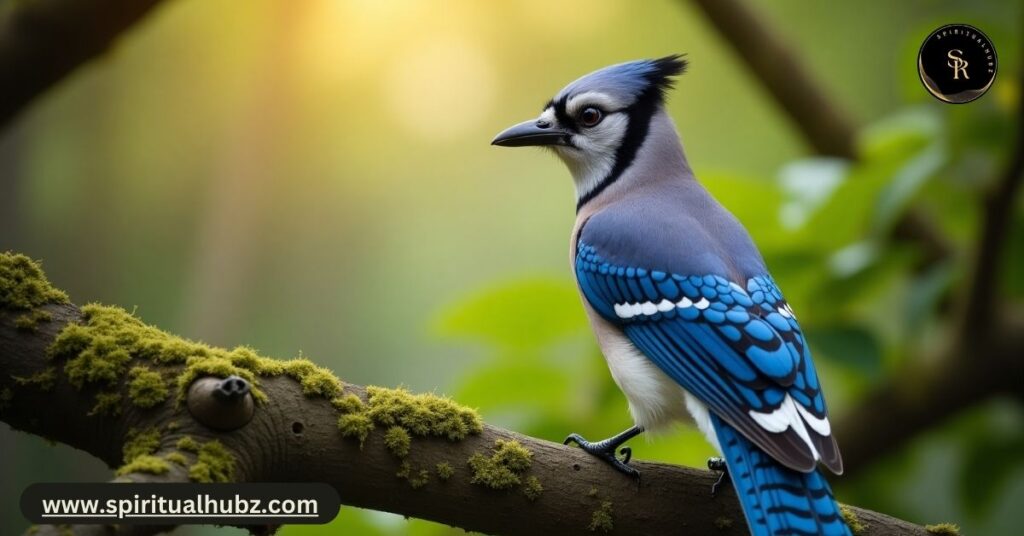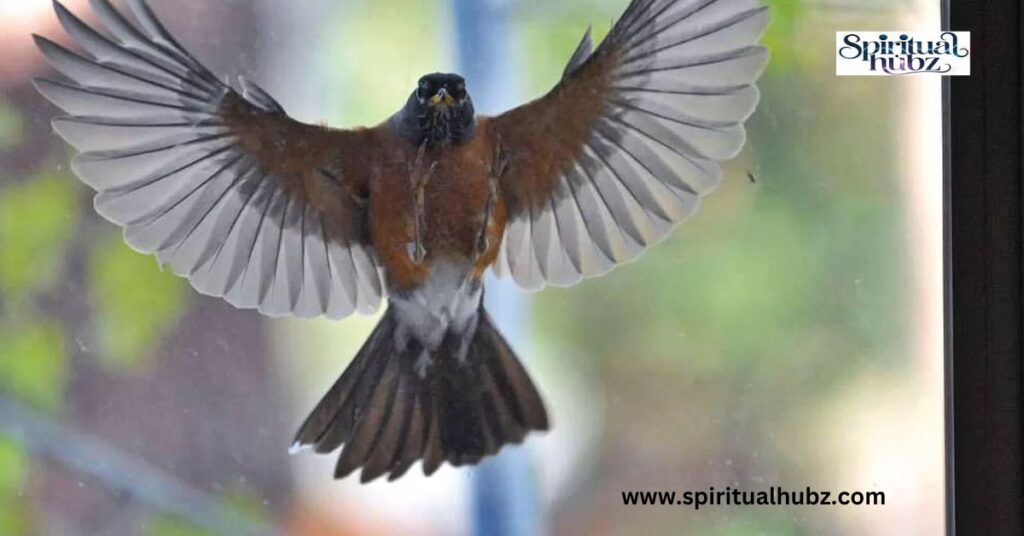Have you ever experienced a blue jay swooping into your yard, its brilliant cobalt blue feathers catching your eye and stopping you in your tracks? This isn’t just another bird visit it’s potentially a powerful spiritual message worth understanding.
Bluejay meaning carries rich symbolism across cultures and spiritual traditions, offering insights that might directly relate to your current life journey. These striking birds aren’t just beautiful to look at; they’re messengers with specific meanings tied to communication, courage, and clarity.
When a blue jay crosses your path, many believe it’s no coincidence. These intelligent birds have captivated humans for centuries, inspiring interpretations about their appearance in our lives.
From Native American belief systems to contemporary spiritual animal symbolism, blue jays consistently represent powerful qualities including protection, truthfulness, and fearlessness. This comprehensive guide will explore what these magnificent birds might be revealing about your life when they appear.
Blue Jay Spiritual Meaning

The spiritual meaning of blue jays centers around clear communication and the courage to use your voice. With their striking blue color, blue jays connect strongly to the throat chakra, the energy center governing expression and truth-telling.
When a blue jay appears in your life, it often signals that you need to speak your truth more boldly or pay attention to how you’re communicating with others. Their loud, unmistakable calls remind us that sometimes our voices need to be heard above the noise.
Blue jays also embody a fascinating duality in the spiritual world they’re both beautiful and assertive, intelligent and sometimes mischievous. This reflects the complex nature of human communication itself.
Their stunning appearance paired with their territorial nature teaches us about setting boundaries while maintaining our authentic beauty. Many spiritual traditions see the blue jay as a spirit guide that helps us navigate the sometimes challenging waters of human interaction, encouraging us to stand firm in our truth while maintaining harmony.
When this bold bird appears repeatedly, it might be time to examine your communication patterns or prepare to receive important messages.
Table of Symbolic Attributes
The blue jay’s spiritual significance can be better understood by breaking down its key attributes:
| Attribute | Spiritual Significance |
| Blue Color | Truth, clarity, communication, connection to divine realms |
| Crest | Heightened awareness, crown chakra connection, higher thinking |
| Bold Calls | Speaking truth, making yourself heard, announcing your presence |
| Black Necklace | Protection from negative energies, boundary-setting |
| Intelligence | Wisdom, resourcefulness, cleverness, adaptability |
| Territorial Behavior | Setting boundaries, protecting your energy, standing your ground |
| Mimicry Ability | Adaptability, survival skills, learning from others |
| Caching Food | Preparation, planning ahead, resource management |
| Community Behavior | Social connections, family importance, community support |
| Feather Finding | Messages from spirit world, validation, divine guidance |
Blue Jay vs. Bluebird: How Their Meanings Differ
While many people confuse blue jays with bluebirds, their spiritual meanings differ significantly. Bluejay meaning messengers of truth and assertiveness, encouraging you to stand your ground and speak up.
They represent protection, wisdom, and sometimes serve as warnings. Their bold presence can’t be ignored, much like the important truths they ask you to face. The blue jay teaches lessons about courage and fearlessness in communication.
Bluebirds, on the other hand, carry gentler spiritual symbolism related to happiness, fulfillment, and gentle transformation. Where blue jays command attention, bluebirds softly remind us of joy and hope. The bluebird symbolizes optimism and good fortune while the blue jay represents clarity and truth.
Understanding this distinction helps you interpret which message is being sent your way based on which blue messenger appears. Both birds connect to spiritual growth, but they represent different aspects of the journey.
Understanding The Symbolism of the Bluejays

Blue jays serve as spiritual protectors and guardians in many traditions. They’re often seen as spirit guides for truth-seekers, educators, and those pursuing knowledge. The blue jay acts as a sentinel, keeping watch and alerting others to potential dangers a role they literally play in forest ecosystems by sounding alarms when predators approach.
This protective quality extends to their spiritual symbolism, where they’re believed to guard against negative energies and deception.
The blue jay’s connection to wisdom runs deep. Their intelligence and problem-solving abilities remind us to approach life’s challenges with cleverness and adaptability. Their forward-thinking behavior of storing food for future use symbolizes preparation and planning.
Many who work with animal symbolism see the blue jay as a reminder to stay alert, think ahead, and trust your instincts. When a blue jay appears, it might be suggesting you need to protect something valuable in your life or prepare for future needs.
Range & Identification
The blue jay (Cyanocitta cristata) stands out among backyard birds with its unmistakable appearance. These crested songbirds measure between 9.8-11.8 inches in length with a wingspan of 13.4-16.9 inches and weigh 2.5-3.5 ounces.
Their most distinctive feature is their vibrant blue upperparts contrasted with white underparts and a black “necklace” across the throat. Their bold crest raises and lowers depending on their mood, giving clues to their emotional state. The wings and tail show black bars and white patches that flash brilliantly during flight.
Found primarily in eastern and central North America, blue jays range from southern Canada to Florida and from the Atlantic coast to the Rocky Mountains. They’ve gradually expanded their range westward over the past century.
Their presence in both rural and urban settings makes them familiar to many Americans. The blue jay’s striking appearance contributes to its spiritual significance their brilliant blue coloration connects them to sky energy and higher realms of consciousness, while their clear markings represent clarity and truth.
Read More About : Birds as Positive Symbols: The Blue Bird Meaning and Their Biblical Context|2025
Migration & Range Maps
Blue jays demonstrate fascinating migration patterns that vary by region and individual bird. While some blue jays remain year-round residents in their territories, others migrate seasonally. This partial migration behavior often puzzles researchers, as birds from the same area may make different decisions about whether to travel.
When they do migrate, blue jays typically travel by day, often in loose flocks, following coastlines and ridgelines as they head southward in fall and northward in spring.
The blue jay’s complex migration represents spiritual lessons about adaptability and knowing when to stay or move on. Their ability to thrive in diverse environments from the Eastern Canada boreal forests to Texas scrublands and Southeastern US oak woodlands speaks to their adaptability.
This adaptability carries spiritual significance about resilience and finding your place in changing circumstances. The blue jay’s migration patterns remind us that sometimes maintaining your position is wisdom, while other times moving forward becomes necessary for growth.
Description
The blue jay possesses a striking and unmistakable appearance that makes it immediately recognizable among native birds. Its brilliant blue crown, wings, and tail contrast beautifully with its white face and underparts. A black “necklace” wraps around its throat, extending to the back of its head.
This distinctive crested songbird boasts a prominent blue crest that raises and lowers depending on its mood standing tall when the bird is excited or aggressive, lying flat when relaxed or afraid. The wing and tail feathers show black bars and white tips, creating a stunning display during flight.
Males and females look nearly identical, making gender identification challenging without behavioral clues. Young blue jays appear similar to adults but with slightly duller plumage and less defined markings.
Their cobalt blue feathers result not from pigment but from light refraction in the feather structure a physical phenomenon rather than chemical coloration. This physical basis for their blue color connects to their spiritual meaning of authenticity and truth they don’t “manufacture” their beauty but reveal it through their natural structure.
Songs and Calls
The vocal repertoire of the blue jay is remarkably diverse, making these birds among the most vocal and expressive backyard birds in North America. Their most recognizable call is the harsh, loud “jay-jay” that gives them their name, often serving as an alarm call to warn others of predators.
But their bird sounds extend far beyond this signature call. Blue jays can produce an astonishing variety of vocalizations including liquid, musical “queedle-queedle” notes, rattles, whistles, and even squeaky sounds resembling a rusty gate.
Perhaps most impressive is the blue jay’s remarkable mimicry ability. They’re known to perfectly imitate the screams of Red-shouldered Hawks, fooling other birds and sometimes even experienced birders.
This bird mimicry serves multiple purposes scaring away competitors from food sources, testing for predator presence, or possibly even entertainment. The blue jay’s complex bird communication reflects their spiritual connection to expression and truth.
Their vocal range symbolizes the importance of adapting your communication style to different situations while maintaining your authentic voice.
Habitat
Blue jays thrive in a variety of wooded environments, showing particular preference for oak woods and mixed woods with abundant nut-producing trees. They favor forest edges rather than deep forest interiors, which aligns with their opportunistic nature.
These adaptable birds have successfully colonized suburban gardens, city parks, and well-wooded suburbs, demonstrating remarkable flexibility in habitat selection. Their preference for edge environments connects to their spiritual symbolism of being messengers between worlds comfortable at the boundary between wilderness and civilization.
While blue jays show remarkable adaptability, they generally avoid coniferous forest areas unless mixed with deciduous trees. This preference for deciduous trees, particularly oaks, relates to their feeding habits acorns form a substantial part of their diet.
The blue jay’s habitat choices reflect their spiritual traits of adaptability and resourcefulness. Their successful integration into human-modified landscapes demonstrates resilience and pragmatism qualities often associated with their spiritual meaning. When a blue jay appears in your environment, it may be reminding you to adapt to your circumstances while maintaining your essential nature.
Behavior
Blue jays display a fascinating range of behaviors that reveal their intelligence and complex social structure. These birds exhibit remarkable problem-solving abilities, quickly figuring out mechanisms of bird feeders or finding ways around obstacles.
They’re highly social, forming strong family bonds and sometimes traveling in small family groups or larger flocks, especially during migration seasons. Their communication extends beyond vocalizations to include body language their crest position alone communicates various emotional states from relaxed to highly alert.
Perhaps most impressive is the blue jay’s caching behavior. They store food items, particularly nuts and seeds, for future use, demonstrating impressive spatial memory by retrieving these items later. This forward-thinking behavior connects to their spiritual symbolism of preparation and resource management.
Blue jays also serve as forest planters they bury acorns that they sometimes forget, effectively planting oak trees. This behavior has led some Native American traditions to view the blue jay as a creator and nurturer. The blue jay’s behavior embodies intelligence, community awareness, and foresight qualities that inform their spiritual meaning as messengers of wisdom and preparation.
Eggs
Blue jay eggs represent new beginnings and potential in the spiritual world. These eggs are greenish or buff-colored with brown or gray spots, measuring about 1 inch in length. A typical clutch contains 3-6 eggs, which the female incubates for approximately 17-18 days.
Both parents share responsibility for protecting the nest during this vulnerable period. The speckled pattern of these eggs serves as camouflage, helping them blend with their surroundings for protection.
In spiritual symbolism, eggs universally represent potential, birth, and new beginnings. The blue jay’s eggs specifically connect to new ideas and creative projects that require protection and nurturing before they can hatch into reality.
Finding a blue jay nest with eggs might spiritually suggest that your ideas need continued protection and patient development before being revealed to the world. The shared incubation between mates reflects the spiritual message about partnership and the importance of support systems when bringing new creations into being.
Young
Blue jay nestlings begin life completely dependent on their parents, hatching naked, blind, and helpless. Both parents participate actively in feeding and caring for the young, bringing a variety of foods including insects, which provide the high protein needed for rapid growth.
Young blue jays develop quickly, growing feathers within days and typically leaving the nest (fledging) after about 17-21 days. However, the family stays together for weeks or even months afterward, with parents continuing to feed and teach their offspring essential survival skills.
The young birds’ development carries significant spiritual symbolism about growth and learning life lessons. Young blue jays learn crucial skills like foraging techniques, predator recognition, and complex social interactions from their parents. This learning period connects to spiritual growth and mentorship.
The fledgling stage when young birds have left the nest but still depend on parents parallels human development stages where we venture into the world while still needing guidance. When young blue jays appear in your environment, they might symbolize your own growth process or suggest you’re in a learning phase that requires patience and support.
Read More : 7 Rare Blue Cardinal Meanings: Spiritual Symbols, Dreams & Omens
Feeding Behavior
Blue jays demonstrate remarkable intelligence and versatility in their feeding behavior. These opportunistic omnivores employ various techniques to secure food, from cracking nuts and seeds with their powerful bills to using their feet to hold food items while pecking them open.
They’re famous for their throat pouch, which allows them to transport multiple acorns or other large food items. This adaptation enables them to cache food for future use, demonstrating remarkable memory by retrieving these items later.
Their diet changes seasonally, showing impressive adaptability. In spring and summer, they consume more protein-rich insects and occasionally small vertebrates, while fall and winter see increased consumption of plant materials, especially nuts and seeds. This dietary flexibility reflects their spiritual trait of adaptability and resourcefulness.
When blue jays visit your yard, they might be bringing a spiritual message about adaptability or reminding you to prepare for future needs. Their feeding behaviors embody the balance between immediate consumption and future planning a wisdom that applies to many aspects of human life.
what do blue jays eat
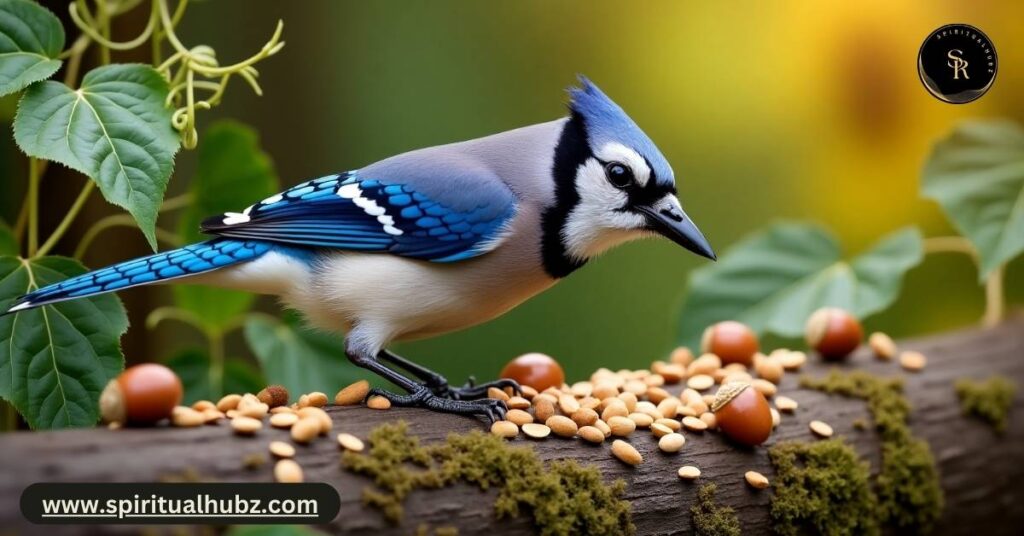
Blue jays maintain an impressively diverse diet that changes with seasonal availability. Their favorite foods include acorns and other nuts, making them important seed dispersers for oak trees.
They readily consume various seeds, including sunflower seeds from bird feeders. The blue jay’s diet also includes a wide range of insects like caterpillars, beetles, grasshoppers, and spiders. They’ll opportunistically eat fruits, berries, and grains when available.
The omnivorous bird occasionally surprises observers with more unusual food choices. They’ve been documented eating small vertebrates like frogs and mice, raiding nests for bird eggs and nestlings, and even consuming carrion.
At bird feeders, they show a particular fondness for peanuts, whole corn, and suet cakes. Their varied diet connects to their spiritual meaning of resourcefulness and adaptability. When blue jays appear at your feeder, they might be bringing a message about diversifying your own resources or adapting to use what’s available to you.
Nesting
Blue jay nesting behaviors reveal fascinating aspects of their family life and priorities. These birds typically build their nests in the vertical crotch of trees or large shrubs, preferring deciduous species at heights of 8-30 feet above ground. Both partners participate in nest building, though females typically take the lead.
They construct an open cup nest using twigs, grass, and small roots, often lined with softer materials like moss, rootlets, and sometimes human-made materials like paper or string. The finished moss-lined nests measure approximately 7-8 inches in diameter.
The nesting period represents a time of vulnerability and focus for blue jays. They become more secretive during this time, often approaching their nests indirectly to avoid revealing its location to predators.
This behavior shifts dramatically from their usually bold presence. The nesting behavior connects to their spiritual symbolism of home, foundation, and family protection. When you see blue jays gathering nesting materials, it might symbolize your own need to create safe spaces or establish stronger foundations in your life.
Their careful nest-building techniques reflect values of security, preparation, and family bonds.
Conservation
The conservation status of blue jays currently remains stable, with populations showing slight increases in recent decades according to data from the North American Breeding Bird Survey. The species is listed as “Least Concern” on conservation watchlists.
Their adaptability to human-altered landscapes has helped them maintain healthy populations even as many other bird species decline. Blue jays have successfully colonized suburban and urban environments, taking advantage of bird feeders and planted trees.
Despite their current stability, blue jays face various challenges including habitat fragmentation, pesticide use, and vehicle collisions. Their role in forest ecosystems makes their conservation important they help spread oak trees by caching and forgetting acorns, contribute to insect control, and serve as alarm systems for other wildlife.
From a spiritual perspective, the blue jay’s conservation status reminds us of resilience and adaptability in changing circumstances. Their ability to thrive despite environmental changes reflects their spiritual significance as messengers of adaptability and resourcefulness.
Conservation Status
Blue jays currently enjoy a conservation status of “Least Concern” according to the International Union for Conservation of Nature (IUCN) Red List. Their estimated global breeding population exceeds 13 million, with about 87% living in the United States and 13% in Canada.
Since the 1960s, blue jay populations have shown remarkable stability, even increasing slightly in many regions according to the North American Breeding Bird Survey. This population stability reflects the species’ adaptability and successful integration into human-modified landscapes.
The blue jay’s conservation success story carries spiritual significance about resilience and adaptability.
Unlike many specialized species that decline when their habitats change, blue jays have found ways to thrive alongside human development. This adaptability connects to their spiritual message about finding opportunity in change and maintaining your essence while adjusting to new circumstances.
Conservation organizations like the Cornell Lab of Ornithology and Audubon Society continue monitoring blue jay populations as part of broader efforts to understand and protect North American birds.
Read More About : Dead Bird Meaning: Know 15 Spiritual Messages Across Cultures
Climate Map
Climate models reveal how blue jay ranges may shift under different warming scenarios. Under moderate climate change projections, blue jays may experience range expansions northward into previously unsuitable Canadian territories.
The birds’ current range encompasses regions with average annual temperatures between 35-70°F (2-21°C) and yearly precipitation of 20-60 inches (50-150 cm). These preferences help scientists predict how their distribution might change as climate patterns shift.
The Audubon Society’s “Survival By Degrees” report classifies blue jays as having “stable vulnerability” to climate change meaning they face moderate threats but show adaptability that may help them adjust.
Their current range may shift northward while potentially contracting in southern portions. This geographic adaptability connects to the blue jay’s spiritual traits of resilience and flexibility. Their ability to adjust to changing climate conditions reflects their spiritual message about adapting to life’s changes while maintaining your core identity.
Climate Threats Facing the Blue Jay
Despite their adaptability, blue jays face several specific climate threats that could impact their populations in coming decades. Changing precipitation patterns may affect food availability, particularly acorn production, which forms a substantial part of their diet.
More frequent extreme weather events like heat waves, severe storms, and droughts could disrupt breeding cycles and reduce nesting success. Shifting seasons may create mismatches between blue jay breeding times and peak food availability, particularly insect populations that emerge based on temperature cues.
These climate challenges connect to the blue jay’s spiritual meaning of adaptability and resourcefulness. Their response to these threats will likely involve behavioral adaptations and potentially range shifts.
The blue jay’s resilience in the face of environmental change carries a spiritual message about facing life’s challenges with flexibility and determination. Organizations like Audubon recommend climate-smart forestry practices and maintaining diverse tree species, particularly oaks, to support blue jay populations through climate transitions.
Individual climate solutions like maintaining native plants and reducing carbon footprints can help protect these important messengers and their spiritual significance for future generations.
What Is the Prophetic Meaning of the Blue Jaybird?
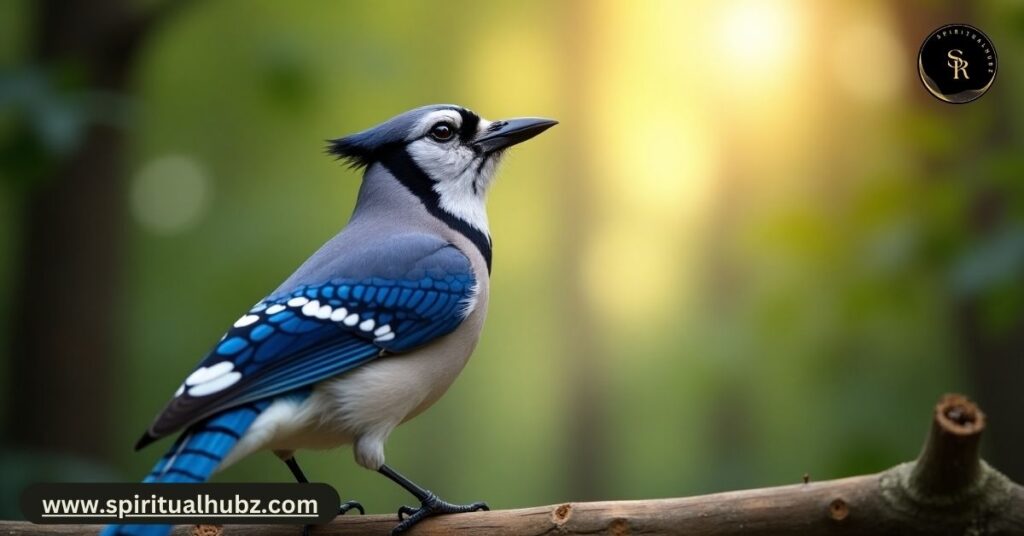
The prophetic meaning of the blue jay centers around divine guidance and alignment with your life purpose. When these striking birds appear, many spiritual traditions interpret it as confirmation that you’re moving in the right direction along your spiritual path.
Their appearance might validate decisions you’ve recently made or actions you’re contemplating. The blue jay’s role as a messenger between worlds makes them particularly significant as prophetic signs that your prayers or intentions have been heard by the divine.
In prophetic traditions, the blue jay’s loud call and bold presence can indicate that important information or revelations are forthcoming. Their appearance might suggest you need to pay closer attention to your surroundings, as important messages are trying to reach you.
Some traditions view repeated blue jay sightings as warning signs about deception or hidden truths that need uncovering. The blue jay’s natural behavior of sounding alarms when predators approach translates spiritually to warnings about potential challenges or deceptive influences in your life. When interpreted prophetically, the blue jay encourages discernment and spiritual awareness.
What Does it Mean Spiritually to See a Blue Jay
Encountering a blue jay carries profound spiritual meaning related to truth, communication, and personal power. When a blue jay crosses your path, it often signals that you need to examine how you’re expressing yourself are you speaking your truth or holding back? The blue jay’s connection to the throat chakra emphasizes clear, honest communication.
Their appearance might encourage you to find your voice in situations where you’ve remained silent or to consider whether your words truly align with your deeper truth.
The timing and context of a blue jay sighting influence its interpretation. A blue jay appearing during a period of decision-making might suggest you need more clarity or courage to express your authentic choice. If you see one while contemplating a communication challenge, it might validate your instinct to speak up.
The blue jay’s bold presence reminds us that truth, while sometimes uncomfortable, serves our highest good. Their intelligence and adaptability suggest that finding clever, appropriate ways to express truth matters as much as the truth itself.
When you see a blue jay, consider where in your life you might need to communicate more boldly or listen more carefully to messages coming your way.
What Does It Mean When a Blue Jay Visits You Repeatedly?
When a blue jay makes repeated appearances in your life, it signals an intensified message requiring your attention. This persistent visitation suggests that whatever spiritual guidance the blue jay brings is particularly important for your current life situation.
The blue jay’s repeated presence might indicate you’ve been ignoring or missing an important truth or message. Their increasing presence serves as a gentle but insistent reminder that something needs your awareness.
Repeated visits from blue jays often relate to communication issues that need addressing. Perhaps you’re avoiding an important conversation, struggling to express your truth, or failing to listen to others.
The blue jay’s persistence indicates that resolving these communication challenges is crucial for your spiritual growth. In some traditions, repeated blue jay sightings signal that ancestral guides or spiritual beings are trying to communicate with you. Their frequency might correspond to the urgency of the message or the strength of the connection being established.
If blue jays continue appearing in your environment, consider keeping a journal of these encounters, noting the circumstances and your thoughts at each sighting to help discern patterns in their messages.
Read More About : Beware! Egret Spiritual Meaning : 15 Positive Messages Which Might Shock You!
What Is the Spiritual Connection To Blue Jays?
The spiritual connection to blue jays centers on their role as intermediaries between physical and spiritual realms. Many traditions view these birds as messengers that can traverse the boundary between worlds, carrying communications between humans and spiritual beings.
Their striking blue color connects them to sky energy and higher consciousness, while their terrestrial lives keep them grounded in the physical world. This dual nature makes them perfect spirit world messengers, able to translate higher wisdom into practical guidance.
Blue jays often appear at spiritually significant moments during meditation, prayer, or times of contemplation. Many people report seeing blue jays shortly after the passing of loved ones, interpreting their presence as visitations from the departed or confirmations that they’ve transitioned peacefully.
The blue jay’s ability to mimic other birds’ calls symbolizes their capacity to translate messages between different dimensions or states of consciousness. Their spiritual connection invites us to become more aware of the messages constantly flowing between physical and spiritual realms.
When you feel drawn to blue jays or notice their increased presence, it might indicate an opening of your spiritual awareness or a strengthening of your connection to higher self and intuition.
Is It A Good Omen to See A Blue Jay?
Seeing a blue jay is generally considered a positive omen in most spiritual traditions. Their appearance often signals protection, guidance, and divine attention to your life journey. The blue jay’s bold presence can indicate that supportive spiritual forces are watching over you and offering protection.
Their striking appearance tends to catch our attention at precisely the moments when we need reassurance or confirmation that we’re on the right path.
The blue jay as a good fortune symbol relates to their intelligence and resourcefulness. When one appears, it might suggest that you have the internal resources and divine support needed to overcome current challenges. In some traditions, blue jays represent victory and prosperity, suggesting that your efforts will bear fruit.
Their territorial nature spiritually translates to protection of your personal energy and boundaries. However, the specific interpretation depends on your personal circumstances and the context of the sighting. A blue jay appearing during a difficult decision might affirm your choice, while one appearing during conflict might encourage you to stand your ground with integrity and intelligence.
Their positive sign nature doesn’t mean avoiding challenges but rather approaching them with confidence and divine support.
The Spiritual Meaning of the Blue Jay’s Red Color
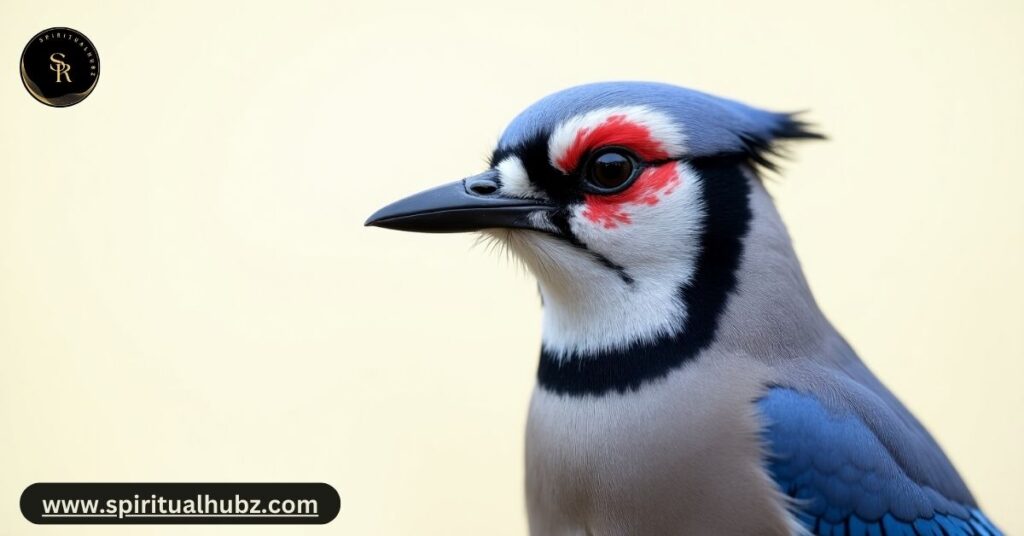
The subtle red markings sometimes found on blue jays carry significant spiritual meaning often overlooked in favor of their dominant blue coloration. Not all blue jays display prominent red markings, but when present, these patches typically appear on the shoulders and upper wings.
This red coloration symbolizes passion, vitality, and life force energy. The red aspects of the blue jay represent the physical, energetic dimensions of life that complement their blue spiritual energy.
This color duality reflects an important spiritual message about balancing earthly and divine aspects of existence. Blue represents truth, spiritual communication, and higher consciousness, while red embodies physical energy, passion, and action.
The blue jay carrying both colors teaches us to integrate these seemingly opposing forces. Their appearance might encourage you to balance your spiritual practices with grounded, passionate action in the material world.
When you notice the red markings on a blue jay, consider whether you need to invigorate your spiritual practice with more physical engagement or bring more spiritual awareness to your physical activities.
This color combination reminds us that complete spiritual development requires harmony between heavenly and earthly aspects of our nature.
Blue Jay as a Spirit Animal: Strengths, Messages & Warnings
When the blue jay appears as your spirit animal, it brings powerful strengths including assertiveness, intelligence, and adaptability. Those guided by blue jay energy often excel at clear communication and finding creative solutions to complex problems.
The blue jay spirit guide encourages bold self-expression and the courage to stand your ground when necessary. People with this spirit animal typically demonstrate remarkable resilience and resourcefulness, much like the bird itself.
The blue jay as spirit guide delivers important messages about truth and boundaries. It warns against being silenced or diminished by others, encouraging you to use your voice effectively. However, it also brings warnings about potential misuse of communication becoming overly aggressive or using intelligence to manipulate rather than illuminate.
The blue jay’s sometimes territorial behavior warns against becoming too defensive or inflexible. Finding balance between assertiveness and cooperation becomes an important lesson for those with this spirit animal.
When the blue jay appears as your guide, it asks you to examine how you’re communicating your truth and protecting your boundaries while remaining open to connection and community.
Blue Jay vs Cardinal: Spiritual Meanings Compared
Blue jays and cardinals both carry powerful spiritual meanings, but they deliver distinctly different messages when they appear. The blue jay emphasizes communication, truth-telling, and sometimes serves as a warning about deception or the need for discernment.
They represent intellectual clarity, strategic thinking, and the courage to speak up. The blue jay’s energy tends to be more assertive and action-oriented, encouraging you to engage actively with life’s challenges.
The cardinal, by contrast, brings messages of hope, renewal, and faith. Their brilliant red coloration connects to passion, vitality, and matters of the heart rather than the mind. Many traditions view cardinals as messengers from departed loved ones, bringing comfort and reassurance.
When blue jays and cardinals appear together, it suggests a powerful balance between head and heart, intellect and emotion. This rare combination might indicate a need to integrate these complementary energies in your approach to a current situation.
The appearance of both birds could suggest that a complete response requires both clear-minded truth (blue jay) and compassionate heart-centered action (cardinal).
Blue Jays in Cultural and Religious Contexts

Throughout history, blue jays have held significant places in various cultural and religious traditions. In many Native American beliefs, the blue jay serves as a trickster figure who uses intelligence and adaptability to navigate challenges.
The Chinook and Coast Salish peoples associate blue jays with creativity and innovation. Their striking appearance and intelligence led to their association with transformation and magic in many indigenous stories. Some tribes considered the blue jay sacred, believing it carried messages between humans and the divine.
In Christian symbolism, the blue jay’s blue coloration connects to heavenly virtues, particularly faithfulness and dedication. Their tendency to mate for life reinforces these associations with loyalty and commitment.
Some Christian interpretations view the blue jay’s bold calls as encouragement to proclaim faith fearlessly. In contemporary spiritual practices, blue jays often appear in awareness exercises and nature-based meditations as reminders of mindfulness and presence.
Their appearance in different religious contexts consistently emphasizes their role as messengers and symbols of clear communication between earthly and divine realms.
The Spiritual Meaning of Blue Jays at Your Window
When a blue jay appears specifically at your window, it carries heightened spiritual significance related to your personal space and attention. Windows symbolize perspectives and transitions between inner and outer worlds.
A blue jay at your window might be deliberately seeking your attention, bringing an urgent message that requires your awareness. This visitation often indicates that important information or insights are trying to reach your conscious awareness.
Many traditions interpret a blue jay at the window as an ancestor or spirit guide attempting direct communication. The bird’s persistence at this threshold between your private space and the outside world emphasizes the importance of the message.
Areas of life needing attention might include communication issues, boundary concerns, or truth that needs expression. Some believe these window visits occur when you’re particularly receptive to spiritual guidance or when divine forces are trying to break through routine thinking patterns.
If a blue jay repeatedly visits your window, consider what messages you might be missing or what truths you may be avoiding. Their appearance at this symbolic threshold invites you to expand your perspective and receive guidance from beyond your normal awareness.
What does the blue jay feather represent in a twin flame journey?
In a twin flame journey, finding a Blue Jay feather is a powerful spiritual sign often symbolizing clarity, divine communication, and soul alignment. The Blue Jay’s vibrant blue hue is linked to the throat chakra, suggesting that open, honest communication is essential for twin flame unions. This feather may appear when you’re being guided to trust your voice, speak your truth, or reconnect with your counterpart on a deeper emotional or spiritual level.
For those on a USA-based spiritual path, especially where Native American and New Age beliefs intersect, the Blue Jay feather also represents loyalty, protection, and courage qualities essential in the often intense, mirroring dynamic of twin flame relationships. Seeing this feather might mean the universe is affirming your connection, urging you to stay resilient and aligned with your higher purpose, even during periods of separation or emotional turbulence.
Read More : Do Woodpeckers Signal Spiritual Messages?
The Significance of Seeing Two Blue Jays
Encountering two blue jays together carries special spiritual meaning related to relationships, balance, and harmony. Since blue jays often mate for life, a pair might symbolize partnership, loyalty, and committed relationships.
Their appearance could validate your current relationship or suggest that partnership matters require your attention. Seeing a pair might also indicate that a significant relationship is approaching or that an existing relationship is entering a new phase.
Beyond romantic interpretations, two blue jays often represent balance between different aspects of yourself or your life. They might symbolize the integration of opposing qualities perhaps masculine and feminine energies, logic and intuition, or work and personal life.
Their dual presence emphasizes the importance of harmony and cooperation rather than competition or domination. In some traditions, two blue jays represent successful communication between individuals or between physical and spiritual dimensions.
Their appearance might encourage you to seek greater balance in your communications or to work cooperatively with others toward shared goals. When you see two blue jays together, consider what partnerships or balance issues in your life might benefit from attention and intention.
Blue Jays in Dreams: Insights and Messages

Dreams featuring blue jays carry significant spiritual meaning that often relates to communication, truth, and self-expression. When a blue jay appears in your dreams, it frequently highlights communication issues in your waking life.
The bird’s behavior in the dream provides important context a calling blue jay might suggest you need to speak up about something, while a silent one could indicate withheld communication or unacknowledged truths. Blue jays building nests in dreams often symbolize preparation for new ideas or expressions.
The emotional tone of your blue jay dream offers additional interpretations. Feeling joy or wonder at the blue jay’s presence might indicate positive developments in self-expression or truth-telling.
Fear or anxiety around the bird could reveal concerns about receiving difficult truths or speaking authentically. Flying blue jays in dreams typically represent freedom of expression and spiritual elevation, while injured or trapped birds might symbolize suppressed communication or restricted authentic expression.
Multiple blue jays in dreams often relate to community relationships and how you express yourself in groups. When blue jays visit your dreams, record the details upon waking and reflect on what aspects of communication or truth might be seeking your attention in waking life.
Blue Jay Tattoo Meaning

Blue jay tattoos carry profound symbolic significance that extends beyond mere aesthetic appreciation of these striking birds. A blue jay tattoo often represents boldness, intelligence, and fearless self-expression qualities embodied by the bird itself.
Many choose this design as a permanent reminder to speak their truth courageously or to honor their commitment to authentic communication. The vibrant blue coloration connects to throat chakra energy, making it particularly meaningful for those who value clear expression or work in communications fields.
The placement and specific design elements of a blue jay tattoo further refine its personal meaning. Some incorporate blue jay feathers to symbolize messages from spirit guides or departed loved ones, while others feature the entire bird in flight to represent freedom of expression and spiritual elevation.
Many designs include oak leaves or acorns alongside the blue jay, honoring the bird’s important ecological relationship with these trees and symbolizing strength, endurance, and potential growth.
Whether chosen for spiritual significance, connection to nature, or personal resonance with the bird’s qualities, a blue jay tattoo serves as a powerful emblem of truth, protection, and intelligence.
The Life of a Blue Jay
The life of a blue jay follows fascinating patterns that reflect their intelligence and adaptability. These birds typically live 7-10 years in the wild, though some individuals have been documented reaching 15-17 years.
Their life cycle begins with hatching from speckled eggs into blind, naked nestlings entirely dependent on parental care. After approximately three weeks, young blue jays fledge but remain with their parents for another 1-2 months, learning essential survival skills. This extended family period contributes to their complex social learning and intelligence.
Adult blue jays may form monogamous pairs that stay together for multiple breeding seasons or even life. Their annual cycle includes courtship in early spring, nesting in late spring, raising young in summer, and preparing for winter or migration in fall.
Throughout these seasons, they demonstrate remarkable intelligence, including tool use, food storage, and complex social interactions. Their adaptability allows them to thrive in various environments and weather conditions.
Attracting Blue Jays to Your Backyard
Creating a blue jay-friendly environment in your backyard not only attracts these magnificent birds but also establishes a deeper connection with their spiritual energy and messages. Blue jays respond to thoughtfully designed habitats that address their specific needs for food, shelter, water, and safety.
Since these intelligent birds have excellent memories, consistency in your offerings helps build trust and encourages regular visits. Their presence brings both visual beauty and spiritual significance to your outdoor space, potentially delivering important messages about communication and truth-telling directly to your doorstep.
Successfully attracting blue jays requires understanding their natural preferences and behaviors rather than treating them like generic backyard birds. These assertive, intelligent birds appreciate environments that offer protection from predators while providing their preferred resources.
Creating hiding spots with dense shrubs or small trees near feeding areas helps them feel secure while visiting. Blue jays are naturally cautious and will observe new elements in your yard for days before approaching them, so patience becomes essential when implementing any attraction strategy. Once they’ve accepted your space as safe and resource-rich, you’ll enjoy regular visits from these striking messengers of spiritual wisdom.
Offer a Variety of Food Sources
Blue jays show clear preferences for specific foods that reflect their natural foraging habits in the wild. Peanuts in the shell rank among their absolute favorites, offering both nutritional value and the mental stimulation of cracking them open an activity that appeals to their problem-solving intelligence.
Platform feeders or tray-style offerings work best for these larger birds, as they prefer stable surfaces that accommodate their size. Beyond peanuts, blue jays readily consume black oil sunflower seeds, cracked corn, suet, and various tree nuts including acorns, which form a substantial part of their natural diet. This diverse menu not only attracts them but supports their nutritional needs throughout changing seasons.
The timing and presentation of food offerings significantly impact your success in attracting blue jays to your yard. These birds typically feed most actively during morning hours and late afternoon, making these optimal times for refreshing feeders. Scatter some peanuts or larger seeds on the ground initially to catch their attention since blue jays frequently forage on forest floors in nature.
Once they discover your food sources, consider using specialized feeders with larger perches and openings that accommodate their size while discouraging smaller birds from monopolizing the offerings. Remember that consistency matters deeply blue jays develop routines and will return regularly once they identify your yard as a reliable food source.
Provide Nesting Sites
Creating suitable nesting opportunities significantly increases your chances of attracting resident blue jays rather than occasional visitors. These birds prefer to nest in the crotches of deciduous trees at heights of 8-30 feet above ground, particularly favoring oak and beech trees.
Unlike many backyard birds, blue jays rarely use birdhouses, instead constructing their own open cup nests from twigs, grass, and bark. You can support their nesting needs by maintaining mature deciduous trees in your landscape or planting young oaks that will eventually provide ideal nesting sites.
Leaving some small twigs and natural fiber materials in accessible locations during spring can also provide valuable nesting materials they’ll readily collect.
Blue jays become extremely protective and secretive during nesting season, which typically runs from March through July depending on your location. They appreciate environments that offer privacy and security during this vulnerable period, so dense foliage near potential nest sites helps them feel protected.
Avoid disturbing areas where blue jays appear to be gathering nesting materials or making frequent visits during breeding season, as human activity can cause them to abandon nest sites. Creating a respectful distance allows you to observe their fascinating family behaviors while honoring their need for security.
Successfully hosting nesting blue jays brings the added spiritual benefit of witnessing their full life cycle and the dedicated parenting behaviors that demonstrate their loyal, protective nature.
Read More About : White Bird Meaning : Sightings, Symbolism & Hidden Messages
Create a Water Source
Water features serve as powerful attractants for blue jays, drawing them to your yard for essential drinking and bathing activities that support their health and well-being. These birds appreciate water sources with specific characteristics they prefer bath depths of 1-2 inches with gradual slopes that allow safe entry and exit.
Bird baths with textured bottoms provide better footing than slippery surfaces, making blue jays feel more secure while using them. Elevated baths placed 3-4 feet above ground offer protection from ground predators, though blue jays will use ground-level sources if they appear safe. The sound of moving water particularly attracts their attention, making fountain attachments or solar-powered water wigglers excellent additions to any bird bath installation.
Maintaining clean, fresh water year-round significantly increases your success in attracting blue jays and supporting their spiritual presence in your space. These birds visit water sources most frequently during early morning and late afternoon, especially during hot summer months when hydration becomes crucial.
In winter, heated bird baths provide rare unfrozen water sources that blue jays desperately need when natural water freezes. Regular cleaning prevents algae buildup and disease transmission, creating a sanctuary that supports blue jay health. Positioning water features within sight of protective cover but away from potential hiding spots for predators creates the ideal balance of accessibility and safety that these intelligent birds appreciate.
A well-maintained water source becomes not just a physical resource but a spiritual connection point where blue jay messages can flow into your life.
Where Are Blue Jays Most Commonly Seen in the U.S.?
Blue jays predominantly inhabit the eastern and central regions of the United States, showing their strongest presence in deciduous and mixed woodlands from southern Canada to Florida and from the Atlantic coast westward to the edge of the Great Plains.
The Eastern Seaboard states particularly New England, New York, Pennsylvania, and the Carolinas host particularly robust blue jay populations due to their abundant oak woodlands. The Midwest states of Ohio, Michigan, Indiana, and Illinois also support thriving blue jay communities in their deciduous forests and suburban landscapes.
While their range has gradually expanded westward over recent decades, blue jays remain less common in the Rocky Mountain states and are largely absent from the Pacific Northwest and Southwest regions, where they’re replaced by their cousin species, the Steller’s jay.
Population density varies significantly across their range, with certain regions offering particularly meaningful opportunities for spiritual connection with these birds. The highest concentrations tend to occur where suburban development interfaces with deciduous woodlands, creating edge habitats that blue jays naturally prefer.
States like Connecticut, New Jersey, and Virginia report especially strong year-round blue jay presence. Florida hosts both resident populations and winter migrants, making it an excellent location for blue jay encounters during colder months. Climate change and habitat alterations continue to shift blue jay distributions, with gradual northward expansion occurring as temperatures warm.
For those seeking spiritual connections with blue jays, focusing on oak-dominated ecosystems in the eastern half of the country provides the most reliable opportunities for meaningful encounters with these powerful spirit messengers.
Practical Steps to Connect with Blue Jay Messages

Daily Observation Practice:
- Create dedicated time for quiet blue jay observation
- Sit near windows or in outdoor spaces where blue jays visit
- Focus your complete attention on their movements, calls, and behaviors
- Eliminate distractions from devices or other activities
- Observe patterns in their appearances and behaviors
Blue Jay Journal:
- Document when and where you encounter blue jays
- Note the circumstances of your life during these sightings
- Record immediate thoughts or feelings that arise
- Look for patterns connecting their appearances to specific life situations
- Transform casual sightings into meaningful spiritual communications
Meditation with Blue Jay Energy:
- Find a comfortable position outdoors or near a window
- Close your eyes and visualize blue jay feathers and distinctive calls
- Internally request clear communication and guidance
- Remain receptive to insights, images, or messages that arise
- Practice regularly to strengthen your connection
Create Sacred Objects:
- Use naturally found blue jay feathers as meditation tools (never collect from live birds)
- Place feathers on personal altars to strengthen connection
- Create artwork featuring blue jays through drawing, painting, or digital media
- Wear or carry blue jay imagery as a reminder of their spiritual message
Develop Authentic Connection:
- Allow connections to develop gradually through consistent practice
- Approach with respectful intention rather than forced interpretations
- Be patient with the process of receiving messages
- Express gratitude for blue jay appearances and guidance
- Trust your intuition about the meaning of their presence in your life
Read More About : Hawk Feather Meaning : The Secret Meaning of Finding a Hawk Feather
FAQ’s
What does it mean if you see a Blue Jay?
Seeing a Blue Jay often signifies a message about communication, truth-telling, and courage in your life. These vibrant birds are believed to be messengers between physical and spiritual realms, bringing attention to areas where you need more clarity or honest expression. Many spiritual traditions view Blue Jay appearances as encouragement to speak your truth boldly while remaining alert to important messages coming your way.
Are Blue Jays Aggressive or Protective Birds?
Blue Jays display assertive behavior that’s primarily protective rather than aggressively malicious. They fiercely defend their nests, young, and food sources from potential threats, including larger predators many times their size. This territorial behavior reflects their natural instinct to protect what they value, similar to their spiritual meaning of defending truth and personal boundaries.
What are 3 interesting facts about blue jays?
Blue Jays can mimic the calls of hawks so perfectly they fool other birds and even experienced birders. They plant thousands of trees each year by burying acorns and seeds they later forget, making them vital forest regenerators. Blue Jays aren’t actually blue their feathers contain no blue pigment but instead use light-scattering structures that create the appearance of blue through a physical phenomenon called structural coloration.
When God sends a Blue Jay?
Many believe God sends a Blue Jay as a divine messenger when you need encouragement to speak truth or when important communication requires your attention. Their appearance often coincides with times when divine guidance about clear expression or boundary-setting would be particularly helpful in your life. Their striking blue color, connected to heavenly realms in many traditions, reinforces their association with spiritual messages from higher powers.
What does it mean when a blue jay bird visits you?
A Blue Jay’s visit often carries a message about authentic communication and expressing your truth with confidence. Their appearance might signal that you need to pay attention to how you’re communicating or to important messages trying to reach you from others or the spiritual realm. Many traditions interpret these visits as confirmation that you’re aligned with your authentic path, especially when they occur during meaningful moments of decision or contemplation.
What is the spiritual meaning of the bluebird?
Bluebirds symbolize happiness, fulfillment, and hopeful transformation, distinct from the Blue Jay’s message of truth and assertiveness. They represent joy, contentment, and the arrival of good news or positive developments in your life. Many traditions associate bluebirds with gentle emotional healing, springtime renewal, and the sweet aspects of life that bring simple happiness rather than the bold communication aspects that Blue Jays represent.
Are blue jays friendly to humans?
Blue Jays demonstrate cautious intelligence rather than outright friendliness in their interactions with humans. They can recognize individual people who regularly feed them and may grow more comfortable with consistent, non-threatening human presence over time. These intelligent birds maintain a natural wariness that serves their survival, but can form loose associations with humans who respect their boundaries and provide reliable resources.
What does it mean when a blue jay stays near you?
A Blue Jay remaining in your vicinity often indicates a persistent message or spiritual presence trying to capture your attention. This behavior might suggest that something important in your life requires closer examination, particularly regarding communication, boundaries, or authentic expression. Many spiritual practitioners interpret a lingering Blue Jay as confirmation that you’re receiving special protection or guidance during challenging times when clear thinking and truthful communication matter most.
Conclusion
Blue Jays bring powerful messages into our lives through their bold presence and striking beauty. These magnificent birds remind us to speak our truth with confidence while staying alert to important communications coming our way. Blue Jays teach us valuable lessons about protecting what matters, using our intelligence wisely, and maintaining clear boundaries in our relationships. Their brilliant blue feathers catch our eye for good reason – they want us to pay attention!
Next time a Blue Jay crosses your path, stop and listen to what this messenger might be telling you. Consider areas in your life where clearer communication could help you grow. Remember that Blue Jays appear when you need courage to express your authentic self or when important messages require your attention.
Connect with these spiritual messengers by creating welcoming spaces in your yard and taking time to observe their wisdom in action. The Blue Jay’s gifts of protection, intelligence, and clear communication await those who welcome their energy.

Gabriel Dawnson is a spiritual writer, dream analyst, and seeker of higher wisdom. With a deep passion for uncovering the hidden meanings behind dreams and spiritual symbols, he has dedicated his work to helping others navigate their spiritual journeys.
As the lead author of SpiritualHubz, Gabriel explores topics such as dream interpretations, angelic messages, numerology, and mystical symbolism. His writings are infused with profound insights, drawing from ancient wisdom, psychological perspectives, and modern spiritual practices.
Gabriel believes that every dream carries a message and that spirituality is a guiding force in understanding life’s deeper purpose. Through his articles, he aims to enlighten, inspire, and empower readers to connect with their inner selves and the universe.

